
After rocketing higher mid-year, silver has spent most of the third quarter drifting sideways to lower. This has naturally weighed on sentiment, with investors and speculators alike growing more bearish during recent months. Yet silver remains way undervalued relative to its primary driver gold, so silver’s young bull market is far from over. This metal’s upside from here is still massive as it mean reverts higher with gold.
Silver has always been exceptionally volatile, which is partially a function of this market’s relatively-small size. The world’s leading authority on global silver supply and demand is the venerable Silver Institute. It reported total worldwide silver demand of 1170.5m ounces in 2015. At last year’s average silver price of $15.68, that works out to an annual market value of $18.3b. That’s practically a rounding error!
According to the World Gold Council, that metal’s top fundamental-research organization, overall global gold demand in 2015 ran 4218.1 metric tons. At last year’s average gold price of $1159, the global gold market was worth $157.2b. Thus silver’s market is only a little over 1/9th the size of gold’s by the latest available read! So any dollar flowing into silver should have about 9x the price impact of one bidding on gold.
At the end of August, fully 260 of the 500 elite component companies of the benchmark S&P 500 stock index had individual market capitalizations larger than the size of 2015’s global silver market! Silver is such a tiny market in the grand scheme that it doesn’t take much investment buying to catapult its price dramatically higher. This great potential for big and fast gains is what makes silver so alluring to traders.
But they don’t get interested in silver until gold flashes a green light. Gold has always been silver’s primary driver. Investors and speculators tend to ignore silver until gold itself has rallied far enough for long enough to convince them its run higher is sustainable. Then they start moving capital into silver, which rapidly blasts its price higher since it is such a small market. This is exactly what’s happened this year.
Back in mid-December, silver was dragged to a miserable 6.4-year secular low by gold falling to its own worst levels in 6.1 years. Futures speculators widely believed the Fed’s coming rate hikes would devastate gold, despite this metal’s long history of actually thriving during Fed-rate-hike cycles. While gold soon started rallying out of those extreme lows driven by enormous gold-ETF buying, silver lagged gold’s advance.
Silver merely rallied 3.1% to gold’s 5.4% in January, and 4.5% to gold’s 10.9% in February. That was terrible leverage of 0.6x and 0.4x, far below silver’s typical 2x to 3x amplification of gold moves. Like so many other times in history, silver didn’t catch a real bid until traders were convinced gold was heading even higher. That critical sentiment shift for new silver bulls finally began in March, before accelerating in April.
Silver climbed 3.7% in March despite gold’s 0.6% retreat, and then soared 15.3% in April to gold’s mere 5.1% gain! This 3.0x leverage proved silver was finally picking up steam in the wake of gold’s new bull market. That big April rally catapulted silver up into an official new bull market of its own, gaining more than 20% since its mid-December low. But the real silver excitement started later soon after that Brexit vote.
On that late-June Friday when this vote’s surprise results first became known, silver only surged 2.6% compared to gold’s epic 4.8% single-day gain. But a few trading days later, silver would rocket with a vengeance to catch up. Over a 3-day span straddling the end of Q2 and dawn of Q3, silver soared 2.9%, 2.6%, and 5.0% higher! That giant 10.8% 3-day surge trounced gold’s 2.3%. Silver was really starting to shine.
Unlike gold which hit a major interim high in early July, silver managed to defiantly grind higher heading into early August. By the 2nd silver’s young bull market had extended to a 50.2% gain over 7.6 months! Traders were starting to get excited about the lagging white metal, right when it was ready to roll over into a healthy correction. Over the next several weeks, silver dropped 10.0% on a minor parallel 3.0% gold loss.
Silver faltering again slammed sentiment, spawning widespread doubts about this young silver bull’s staying power. But this mounting bearishness was unfounded. Even at its early-August bull-to-date peak, silver remained way undervalued relative to gold. Silver not only continued to lag gold, but silver’s price was low absolutely and its young bull was far too small per modern precedent to give up its ghost.
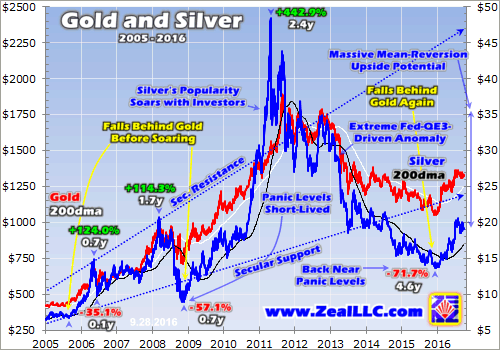
Silver’s powerful bull markets of the past decade or so have all started out the same way 2016’s has, with silver really lagging its primary driver gold. When gold suffers major corrections or bear markets, investors and speculators alike flee silver. Their selling has a disproportionate downside impact since silver’s market is so small, forcing silver to amplify gold’s weakness. But those fearful depths birth major new bulls.
Remember our current specimen has powered 50.2% higher at best so far over 0.6 years. Incredibly that isn’t very impressive at all by silver’s wild standards. Back in 2005 and 2006, silver rocketed 124.0% higher in a similar 0.7-year span. While such big and fast gains left silver drenched in greed which ultimately killed that particular bull, the lesson today is a 50% half-year silver bull is far from exceptional for this metal.
Following a sharp-yet-short-lived bear market, silver’s next bull soon began grinding higher. That would carry silver 114.3% higher in 1.7 years ending in early 2008. That happened to be silver’s smallest major bull market of the modern era, still more than a double. And once again it ended as silver grew popular, with a spike to new bull highs. Soon after that silver got sucked into 2008’s first stock panic in a century.
While silver is a popular investment in some contrarian circles, it is exceedingly speculative. So when anything in the broader markets spooks traders and dampens their desire to take risks, silver sentiment really suffers. This includes sharp stock-market selloffs. While gold drives silver generally, on big stock-market down days silver tends to follow stocks lower. Its losses split the difference between gold and stocks.
So it’s not surprising at all silver was crushed during 2008’s stock panic, an epic maelstrom of fear. This metal was bludgeoned far lower than it should’ve been based on where gold was trading. Those very extreme stock-panic lows birthed silver’s next bull market, which would skyrocket 442.9% higher over the next 2.4 years! It actually climaxed in something of a popular speculative mania, everyone loved silver.
So this year’s 50% bull-to-date gain in silver is nothing. It’s hard to even imagine a silver bull where this metal doesn’t at least double. Silver’s last 3 major bull markets between 2005 and 2011 averaged gains of 227%, well over triples. And when silver bulls start from exceptional fear-laden lows before ultimately growing into speculative-mania-grade popularity, quadruples, quintuples, or even larger gains can be seen.
Provocatively silver’s recent late-2015 lows were every bit as extreme as those 2008 stock-panic ones, as we’ll dig into below. 2016’s young silver bull is emerging out of major 6.4-year secular lows where silver was universally despised. So there are very high odds today’s silver bull will grow much larger than average before it fully runs its course. One potential upside target is the middle of silver’s secular trading range.
It’s technically a massive ascending-broadening-wedge chart pattern, a mouthful. It’s secular in scale, forming over many years between silver’s secular support and resistance lines. Today the midpoint of this huge formation is $35. That’s not even particularly high, as silver averaged over $31 in 2012 before the Fed’s extreme open-ended QE3 money printing started grossly distorting the markets back in early 2013.
A return to just the middle of silver’s secular range would yield a 156% silver bull, far larger than what we’ve witnessed so far in 2016. And technically this target is quite conservative. Past silver bulls have blasted silver up to or above its secular resistance. Today that line is running near $47, which would make for a 243% total bull. Interestingly that’s right in line with the modern-bull average of 227% gains, nothing special.
But all silver’s past major bull markets since 2005 ultimately catapulted this metal to major new highs. If that happens again, silver would have to well exceed April 2011’s $48.43 during its next popular-mania bull climax. Considering mean reversions out of extreme lows tend to overshoot proportionally towards the opposite extreme, seeing major new silver highs when today’s young bull goes terminal isn’t a stretch at all.
None of these potential technical upside targets matter, the core point is this young silver bull remains tiny. It will almost certainly have to grow much larger before silver peaks and faces the risk of its next bear market. A far-stronger argument for why this silver bull has a long ways to run yet has to do with current silver prices compared to prevailing gold levels. Silver is still way undervalued relative to gold.
This is easiest to see through the Silver/Gold Ratio construct. The SGR divides the daily silver close by the daily gold close, although this results in little decimals hard to parse mentally. The same results can be gleaned in a much-easier-to-digest format by using a scale-inverted gold/silver ratio, which I prefer. It yields whole numbers like 69, meaning it takes 69 ounces of silver to equal the value of one ounce of gold.
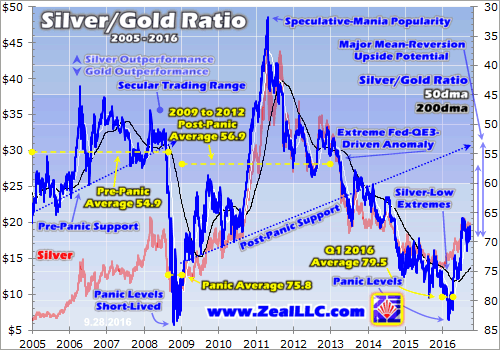
Before 2008’s stock panic, the SGR averaged 54.9. This resulted in that ubiquitous 55-ounce conversion rate used extensively in miners’ financial reporting to convert byproduct gold mined into silver-equivalent ounces or vice versa. During the stock panic, speculative silver cratered far worse than safe-haven gold, so the SGR collapsed to 75.8 during those final months of 2008! Such extremes weren’t sustainable.
All throughout the markets, the more extreme any long-established historical price relationship gets skewed the greater the odds a sharp reversal is imminent. And indeed as I warned right after that panic, silver soon started mean reverting dramatically higher relative to gold. Mean reversions out of extremes also tend to overshoot proportionally towards the opposite extreme, which is exactly what happened after the panic.
While silver had been battered as low as needing 83.5 ounces to equal the value of a single ounce of gold in November 2008, it ultimately rocketed up to a speculative-mania peak of just 31.7 ounces in April 2011! These extremes were polar opposites, epic fear in the depths of a stock panic ultimately yielding to epic greed at the heights of a popular mania. At both extremes silver’s deviation from norms was proportional.
This SGR collapsed 28.6 ounces under that pre-panic 54.9 mean in late 2008 before rocketing 23.2 ounces above it in early 2011. Provocatively despite these wildly-disparate extremes, the normal-year post-panic-average SGR between 2009 to 2012 settled at a similar 56.9. Around 55 ounces of silver per ounce of gold is where silver and gold prices seem to naturally gravitate to. This is a very-bullish omen today!
In early 2013 the Fed’s wildly-unprecedented open-ended third quantitative-easing campaign started to levitate the stock markets. Every time they threatened to sell off, Fed officials would run to the podiums to jawbone about more easing. This arrested all material selloffs, leading to a long totally-artificial streak between 2013 and 2015 where stocks did nothing but rally on balance. That devastated silver investment.
Silver follows gold, and gold tends to move counter to the stock markets. So investors and speculators alike shunned silver in those dark Fed-distorted years when stock markets levitated on extreme easing and the promise of more. This vexing dynamic ultimately hammered silver to its deep 6.4-year secular low of December 2015. But since silver lagged gold’s early-bull advance this year, the SGR kept falling lower.
By late February 2016, the SGR had totally collapsed to 83.2! That was back down to 2008-stock-panic levels, which was the most extreme fear superstorm witnessed in our lifetimes. In the first quarter of 2016, the SGR averaged just 79.5. That was incredibly even lower than the 75.8 seen during those stock-panic months in late 2008. Today’s young silver bull was born in panic-grade extremes of fear and despair!
This guarantees silver is almost certain to not only mean revert relative to gold, but yet again overshoot proportionally. That portends radically-higher silver prices in the coming years as this bull matures. With silver still so seriously undervalued today, the upside targets SGR mean reversions and overshoots augur are amazing. Let’s start with the conservative mean reversion back up to that post-panic average.
At today’s $1325 gold levels, a strict mean reversion stopping at that post-panic-average 56.9 SGR level leaves silver near $23.25. That’s another 22% higher from today’s levels. But this assumes gold isn’t going to continue mean reverting higher in its own strong young bull market. A really conservative gold target is regaining 2012 average levels before the Fed’s extreme QE3 distortions, which ran $1669 per ounce.
At those 2012 gold levels and that post-panic-average SGR, this silver bull’s price target swells near $29.25. That’s another 53% higher from today’s levels, implying the big majority of this silver bull’s gains are still yet to come. That would yield a total silver bull of 114%, right in line with the weakest major bull of the modern era before 2008’s stock panic. But odds are high silver’s mean reversion won’t stop at average.
We don’t even need to expect another popular-mania peak, although one wouldn’t be surprising at all. A fairly-modest mean-reversion-overshoot target would see today’s young silver bull ultimately peak at an SGR of 40. At today’s $1325 gold prices, that yields a silver target of $33.25. That’s 73% higher than today’s levels and leads to a total silver bull of 147%, which is still nothing to write home about by modern standards.
At a gold mean reversion back to 2012’s $1669 average price, a silver-bull-peak SGR of 40 portends a silver price near $41.75. That’s another 118% higher from today’s levels, and would make for a total bull-market gain of 205%! Again these particular upside targets aren’t definitive, they’re just illustrative. The key takeaway is silver still remains way undervalued relative to gold and thus destined to power much higher.
So the recent bearishness generated by silver’s correction is very misplaced. Corrections are normal and healthy in bull markets, they rebalance sentiment by eradicating greed which maximizes bulls’ lifespans. Far from being threats, corrections are the best buying opportunities within ongoing bull markets. And with silver still much too low relative to gold, investors and speculators ought to be buying aggressively.
Silver’s coming big bull-market gains can certainly be played with that leading SLV iShares Silver Trust silver ETF, or physical silver bars and coins. But the problem with pure silver plays is they will obviously only pace silver’s gains. Meanwhile due to the great inherent profits leverage in silver mining, the stocks of the elite silver miners will enjoy silver-bull gains greatly amplifying silver’s underlying bull-market run.
This has already begun in dramatic fashion. In Q2’16, the elite silver miners of the SIL Global X Silver Miners ETF saw their cash flows generated from operations soar a staggering 135% quarter-on-quarter on a mere 13% gain in the average silver price! So the coming doubling, tripling or more in silver prices is going to translate into vastly-higher gains for the best silver miners’ stocks, since their prices ultimately follow profits.
The bottom line is silver is way undervalued today. Its strong new bull market this year is both far too young and far too small to give up its ghost anytime soon. Silver remains quite low in both absolute terms and relative to gold, its primary driver. Silver still has to power much higher merely to mean revert to normal levels compared to today’s prevailing gold prices, let alone where gold is heading in its own bull market.
Corrections within ongoing silver bulls are normal and healthy, rebalancing sentiment by eradicating greed rampant at the preceding interim highs. They offer bulls’ best opportunities to buy relatively low ahead of future uplegs. 2016’s silver bull is alive and well despite the recent correction-weakened sentiment. Once gold inevitably starts powering higher again, silver will follow and amplify gold’s gains like usual.

1. If gold is to move substantially higher and retain the bulk of those gains, inflation needs to become a significant concern.
2. Please click here now. Double-click to enlarge this eight hour bars gold chart. An upside breakout seems imminent, but patience is required.
3. A breakout from that drifting rectangle pattern I’ve highlighted on the chart is significant, because it creates a much bigger breakout on the monthly chart.
4. Please click here now. Double-click to enlarge. Gold is almost ready to begin a significant leg higher.
5. The US presidential debate had almost no effect on the gold price, and that’s because most of the questions had nothing to do with the economy.
6. On that note, please click here now. Double-click to enlarge this interesting 8 hour bars chart of the Dow.
7. The US stock market initially rallied after the debate, but it’s since given back most of those gains.
8. There’s a clear bear wedge pattern in play on the chart, and that follows a breakdown from a head and shoulders top pattern.
9. The bottom line is that the September – October time frame is crash season for the US stock market, and the situation is grim.
10. Who won the debate? Well, mainstream media is essentially socialist, and they say Hillary won.
11. I agree, but please click here now. Social media statistics suggest that Trump won the debate, and that’s because social media was more focused on the economy than mainstream media.
12. There are a lot of Trump fans in the Western gold community, and I suggest they focus on social media as much as mainstream media, to keep on top of the pre-election action.
13. In regards to the potential for inflation, please click here now. Merrill analysts have just issued a blockbuster report, suggesting that a multi-year supply output squeeze is coming.
14. I think they are correct, and this has significant implications for the price of oil, which is by far the single largest component of most commodity indexes.
15. Please click here now. Double-click to enlarge this eight hour bars oil chart.
16. Oil is coiled in a nice bull wedge pattern, and poised to surge towards the $50 area highs, and perhaps to $53.
17. Some oil bears have suggested that electric cars could put pressure on long term oil demand. I agree, but they will put more pressure on oil companies to cancel new mega-projects.
18. Electric cars will not produce a lower oil price, but, ironically, a higher one! There are many factors working synergistically to drive inflation higher, and oil is certainly one of them.
19. I’m getting a lot of emails from investors who are worried that gold stocks could get hit hard if the US stock market crumbles. Here’s the bottom line:
20. There’s no question that there appears to be more margin used in the gold stocks arena than the bullion arena, at the current time.
21. It’s a different situation from 2008. In 2008, hedge funds were forced to liquidate gold to meet margin calls caused by the OTC derivatives crisis.
22. Now, a loss of confidence theme is brewing, with the focus on central banks and government treasury bonds. That means that institutional money managers are much more likely to buy gold in a market meltdown event. Gold stocks can decline initially if the stock market crashes, but they will soon follow gold, and move higher.
23. Please click here now. Double-click to enlarge this GDX chart. Note the position of the Stochastics oscillator, at the bottom of the chart. GDX is more solid here than most investors think.
24. While the presidential debate received a lot of attention, I’ll dare to suggest that tomorrow’s COMEX option expiry is much more likely to be the catalyst that produces a fresh leg higher for gold, and for stock in the companies that mine this mighty metal!

1. The world is about 24 hours away from key BOJ and Fed meetings that could create a sea change in global markets.
2. Please click here now. Double-click to enlarge. This daily bars gold chart shows gold drifting majestically in a rectangular pattern.
3. Strong handed gold investors don’t appear to be worried about the BOJ and Fed meetings, and with good reason; a rate hike from the Fed would create panic in the stock market, and investors would flock to gold, just as they did after the first rate hike in December.
4. If the BOJ announces deeper negative rates, that’s also good news for gold, from a competitive cost of carry perspective.
5. If the BOJ announces “operation twist”, where it buys more short term bonds than long term bonds, institutional money managers will view that as inflationary because it boosts bank lending. That’s more good news for gold.
6. Indian festival buying is also now in play, and demand is likely quite a bit higher there than official numbers indicate, due to the rise of the black market’s share of the market.
7. That festival demand is likely a big reason why gold feels so firm.
8. When the Fed hiked rates last December, gold stocks and the US stock market sold off temporarily, and then a huge rally began.
9. If the Fed hikes rates tomorrow, I would suggest that both the stock market and gold stocks will fall again, but it’s likely that only gold stocks recover quickly this time. The bottom line:
10. It’s possible that a rate hike tomorrow marks the end of the US stock market bull cycle. It’s really been treading water since early 2014, when Janet Yellen began tapering QE.
11. Please click here now. Double-click to enlarge. This monthly bars chart of the Dow shows an ominous broadening top formation may be forming, as the RSI oscillator negatively diverges.
12. Next, please click here now. Double-click to enlarge this daily bars chart of the Dow.
13. From a technical perspective, it’s a horrific situation. There’s a H&S top pattern in play. It’s similar to the formations on the gold stock ETFs, but it sits within a huge bear wedge formation.
14. What about gold stocks? Sadly, Indians don’t buy gold stocks for their festivals. They buy bullion. Gold stocks looked a little shaky recently (with some great exceptions), when global stock markets fell after key Fed representatives spoke.
15. I generally mandate myself to a 30% gold stocks limit for my portfolio. I realize that many gold bugs like to hold much higher amounts of capital in their favourite mining stocks.
16. Significant intestinal fortitude is required to operate with a “go big or go home” approach to gold stocks, but the potential rewards are gargantuan.
17. Please click here now. Double-click to enlarge this daily bars GDX chart.
18. Technically, GDX has a head and shoulders top pattern like the Dow, and the same pattern has appeared on the GDXJ and SIL entities.
19. Gold stocks can be viewed as a canary in the Fed’s coal mine, and it makes sense that a rate hike could bring some pain to gold stock enthusiasts around the world.
20. Regardless, I think that pain would be very temporary, and I’m in some great company in my view.
21. On that note, please click here now. This is a truly spectacular summation of the gold stocks sector in the “here and now” time frame, and it comes from Goldman Sachs’ highly influential research team.
22. The bottom line is this: Fundamentally-oriented liquidity flows from institutional money managers create the chart patterns that technicians see on their charts, and one rate hike from the Fed cannot undo all of the balance sheet repair work that gold mining companies have achieved.
23. While the H&S top patterns and infrequent rate hikes from the Fed need to be respected, the ability of most productive gold mining companies to generate 5% – 8% free cash flow yields for many years is something that commands vastly more respect.
24. It’s going to be an action-packed day tomorrow. I invite all gold stock and silver stock enthusiasts to cast fear aside now, and join myself and top Goldman analysts in placing buy orders slightly below the current market prices, in preparation for tomorrow’s BOJ and Fed announcements!
Stewart Thomson of Graceland Updates, Guest Contributor to MiningFeeds.com

Gold’s young bull market has totally stalled out in the past couple months. This major loss of momentum following gold’s powerful surges in 2016’s first half is really souring sentiment and vexing traders. They are trying to figure out if gold’s recent consolidation drift is the dawn of a new bearish trend or a healthy pause within an ongoing bull. The likely answer comes from understanding what’s causing gold’s high consolidation.
Back in mid-December right after the Fed’s first rate hike in 9.5 years, gold slumped to a miserable new 6.1-year secular low. That was driven by heavy gold-futures selling from speculators, who were utterly convinced higher rates are gold’s mortal nemesis. But with bearishness so extraordinary and investors’ gold allocations so low, a mighty mean reversion higher for gold was very likely in 2016 as I wrote in late December.
Indeed that soon came to pass. As the grossly-distorted stock markets artificially levitated by the Fed’s extreme easings rolled over in January, investors started remembering the wisdom of diversifying some of their portfolios into gold. As a unique asset tending to move counter to stock markets, gold remains the leading diversifier to mitigate downside risks in stock-heavy portfolios. Gold was finally off to the races.
By early March gold formally entered bull-market territory for the first time since mid-2011, surging 20%+ off its deep secular lows. Gold’s enormous 16.1% gain in Q1’16 made for its best quarter in 30 years, since Q3’86! Such a blistering pace of ascent wasn’t sustainable, and gold started faltering in Q2’16. But heavy investment buying was soon rekindled, starting with a colossal US-monthly-jobs miss in early June.
Then in late June, gold rocketed higher again after the surprise success of the British people voting to overthrow the tyranny of those unelected, unaccountable EU bureaucrats. But gold’s newfound post-Brexit strength was short-lived, as it topped at $1365 in early July. In just 6.7 months, gold had blasted an astounding 29.9% higher! So a breather was certainly overdue, especially inside gold’s summer doldrums.
Summer has always been the weakest time of the year seasonally for gold, as it’s devoid of the outsized demand spikes driven by income-cycle and cultural factors that gold enjoys much of the rest of the year. And indeed between that early-July peak and the end of August, gold pulled back 4.1% to $1308. This metal has been drifting in the mid-to-low $1300s for over 9 weeks now, breeding mounting bearishness.
Until last Friday, this summer’s unbelievable stock-market levitation to new record highs offered some cover for gold’s lethargy. As recent years proved in spades, gold investment demand wanes when the stock markets apparently do nothing but rise indefinitely thanks to endless central-bank easing. Why diversify into gold if stocks seemingly never sell off materially? But that levitation finally started to fracture.
A week ago the flagship S&P 500 plummeted in a massive 2.5% single-day loss! That was a stunning wake-up call to the legions of hyper-complacent stock bulls. Yet there was no accompanying surge in gold investment demand for prudent portfolio diversification. The world’s dominant leading gold ETF, the American GLD SPDR Gold Shares, actually suffered a major 1.1% draw that day stock markets rolled over!
So what the heck is going on with gold here? If not even the biggest stock-market down day by far since that late-June Friday when the Brexit-vote results became known could spark some life in gold, what will? The longer gold remains stalled, the more investors’ and speculators’ concerns mount about the health of its young bull. Understanding what’s been holding gold back is critical to gaming its next major move.
Gold’s young bull has stalled due to an interplay between investors’ gold demand, speculators’ gold-futures trading, this summer’s lofty US stock markets, and typical weak mid-year seasonals. Since this year’s powerful gold bull has been driven almost exclusively by investment buying, that’s the place to start. This chart looks at GLD’s gold-bullion holdings overlaid on the gold price during the past couple years.
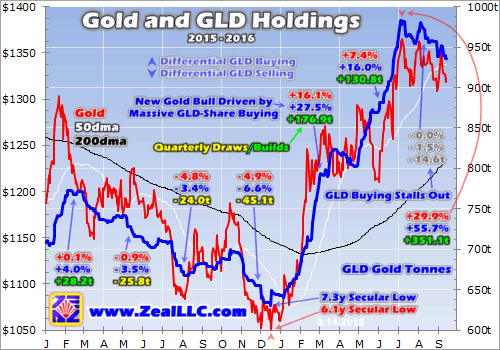
As gold slumped to last year’s major secular lows, its investment demand as evidenced by builds and draws in GLD’s physical gold bullion held in trust for its shareholders waned dramatically. The very day that gold bottomed in mid-December immediately after the Fed’s first rate hike in nearly a decade, GLD’s holdings hit their lowest level in 7.3 years! American stock investors had abandoned gold, leaving it for dead.
But this dire trend soon reversed right out of the gates in early 2016. Thanks to a sharp stock-market selloff, which would snowball to the biggest in 4.4 years for the benchmark S&P 500, investors finally started returning to gold. They began aggressively adding gold exposure via GLD shares, which is the quickest, easiest, and cheapest way by far for mutual funds and hedge funds to buy gold. GLD demand just skyrocketed.
GLD is a tracking ETF, it’s designed to mirror the price of gold. But GLD-share supply and demand is totally independent from gold’s own supply and demand. Thus GLD-share prices always threaten to decouple from gold prices. There’s only one way to neutralize this inherent conflict. Excess GLD-share supply or demand has to be directly shunted into underlying physical gold bullion itself, to equalize any pressures.
So when American stock investors buy GLD shares faster than gold itself is being bought, their prices will soon break away from gold’s to the upside. GLD’s managers have to intervene to maintain tracking. So they issue enough new GLD shares to supply and offset the excess demand, keeping GLD’s price in line with gold’s. Then they immediately deploy the capital raised from these share sales by buying gold bars.
GLD necessarily acts as a direct conduit between the vast pools of stock-market capital and the global physical gold market. So daily builds in GLD’s holdings showing this ETF is buying gold bullion reveal stock-market capital flowing into gold. Heading into February, differential GLD-share demand from big American stock investors, overwhelmingly funds, exploded higher as the stock markets kept tanking.
Take careful note of the timing. In January, GLD’s holdings grew by 4.2% or 26.9 metric tons. But in February they rocketed 16.1% higher in a gigantic 108.0t build! This is a critical lesson for today. Last Friday’s sharp S&P 500 selloff was merely the beginning of stock markets rolling over. Selling pressure has to be sustained, becoming a trend, before stock investors’ complacency crumbles so they once again seek gold.
So far in this latest stock-levitation rollover, we’ve only seen 2 major S&P 500 down days. Last Friday’s 2.5% and this past Tuesday’s 1.5%. While no doubt steep in light of recent months’ record-low volatility, that’s not enough selling to convince stock investors the prevailing trend has decayed to down. We will probably need a couple weeks of selling before they get worried enough to start re-diversifying into gold again.
Back in the first 10 trading days of January, the S&P 500 saw no fewer than 6 major down days! They included daily drops of 1.5%, 1.3%, 2.4%, 1.1%, 2.5%, and 2.2%. Gold investment demand didn’t pick up dramatically until stock investors were really getting spooked by an ongoing hammering. The differential demand for GLD shares forcing holdings builds that drive up global gold prices didn’t come until after that.
So a couple days of material stock-market selling so far in September probably hasn’t been enough yet to shift stock-investor psychology away from this summer’s hyper-complacency. If the stock markets keep grinding lower on balance as they certainly ought to after such an extreme Fed-conjured levitation to new record highs, gold will inevitably catch another major investment bid sooner or later here. Be patient.
And the importance of GLD-share buying by American funds for this gold bull cannot be overstated, it is staggering. In Q1’16, gold surged 16.1% higher on a 27.5% or 176.9t build in GLD’s holdings. The best research available on gold’s actual underlying physical supply and demand comes from the venerable World Gold Council, in its indispensable Gold Demand Trends reports that are published once a quarter.
Back in May the WGC released its Q1’16 GDT. It reported that global gold demand climbed 20.5% year-over-year, or a 219.4t gain. Incredibly, that first-quarter 176.9t build in GLD’s holdings alone accounted for a staggering 80.6% of the total worldwide growth in gold demand! That compares to traditional bar-and-coin demand only rising a trivial 1.7t YoY. GLD gold-bullion buying was the whole story of Q1’16.
2016’s new gold bull exists solely because large American stock investors decided to flood back into gold via GLD shares after neglecting reasonable portfolio allocations to it for years. Gold rocketed up in the first quarter not because small investors were buying bars and coins, but because big ones were buying ETF shares. This gold bull’s incredible dominance by GLD-share buying actually intensified in Q2’16!
In August the WGC released its Q2’16 GDT report, revealing worldwide gold demand surged up another 15.4% or 139.8t YoY. GLD’s Q2’16 holdings build alone of 130.8t accounts for a whopping 93.6% of this total global increase in gold demand! Again world bar-and-coin demand was dead flat, up a trivial 2.5t in the second quarter. Gold’s entire new bull market has been overwhelmingly driven by differential GLD buying.
Now odds are this anomalous GLD-dominating trend won’t persist. As this gold bull lasts longer and marches higher, traditional demand for jewelry in Asia and bars and coins in the West will start growing and flourishing again. ETF buying commandingly led by GLD will hand off the gold-buying baton to other investors. But for now, this entire gold bull is built on the back of GLD. And that’s why gold has stalled.
Differential GLD-share demand has totally evaporated in this almost-over third quarter. As of the data cutoff for this essay on Wednesday, GLD’s holdings had actually fallen 1.5% or 14.6t so far in Q3’16! This modest GLD draw, or more accurately the lack of big ongoing GLD builds, is why gold is dead flat quarter-to-date. Without large American stock investors buying GLD, the entire impetus of gold’s bull has vanished.
There are a few reasons. Differential GLD-share demand was extremely strong after that Brexit vote in late June into early July. Early in quarters is when hedge funds often position capital for those entire quarters. That big fund buying wasn’t sustainable, and soon petered out. That was exacerbated by both the market summer and the shocking resumption of the stock-market levitation back up to new record highs.
All throughout the markets there is a big summer lull as traders’ attention naturally shifts to vacations and leisure. Kids are out of school, the sun is warm and welcoming, so the majority of traders including big fund managers leisurely drift through summer. They loosely watch the markets, but don’t often make major allocation decisions unless forced to. That’s one reason gold has always languished in summer doldrums.
On top of that, the US stock markets surged to new record highs again soon after that pro-Brexit vote that was long-prophesied to spell doom. Gold topped on July 8th, and the very next trading day the S&P 500 edged up to its first new record high in 13.7 months. The failing stock bull was suddenly alive and well again despite the feared Brexit coming to pass. The day after that GLD suffered a major 1.6% draw.
Over two weeks in mid-July, the S&P 500 climbed to new all-time highs in 7 out of 10 trading days! That kind of thing breeds epic complacency, rekindling the stocks-can-rally-forever myth of recent years fed by extreme central-bank easings and jawboning. So with stocks back in vogue in a major way, the allure of counter-moving gold for portfolio diversification evaporated. Just like it had during the past couple years.
Now I fully expect this love-stocks-hate-gold trend to reverse again just like it did back in January. But we first need to see the stock markets sell off for long enough to worry investors that their trend is once again lower. The sharp S&P 500 drops over this past week are a great start, but odds are we’ll need to see a couple weeks of lower stock markets before investors start actively diversifying portfolios into gold again.
They remain radically underinvested. GLD is the best proxy by far for stock-market capital invested in gold. Back in late August, its total physical gold-bullion holdings held in trust for its shareholders were worth $40.3b. Meanwhile the collective market capitalization of all 500 elite S&P 500 stocks was way up at $20,063.4b. So gold investment represented just 0.2% of stock investors’ portfolios by this particular metric!
That’s absurdly low, practically nonexistent. For millennia, the world’s smartest and most-successful investors have advocated having at least 5% of every portfolio invested in gold. And while that bare-minimum goal is likely far too lofty for American stock investors brainwashed into believing gold has no use in the modern world economy, their gold holdings are still very low even by their own recent standards.
The last normal years before this latest artificial stock-market levitation driven by the Fed’s open-ended QE3 campaign ran from 2009 to 2012. During that span, the ratio of the value of GLD’s holdings relative to the total market cap of all S&P 500 components averaged 0.475%. So American stock investors are woefully underinvested in gold today even by their own pathetic precedent, running at just 3/7ths normal levels.
This ongoing radical gold underinvestment despite this year’s huge GLD holdings build is glaringly obvious in this chart. It divides the total value of GLD’s holdings by the collective market capitalization of the S&P 500, or SPX. American stock investors’ investment-capital inflows into gold are only beginning, with the lion’s share yet to come when this artificially-extended stock bull inevitably rolls over into a new bear.
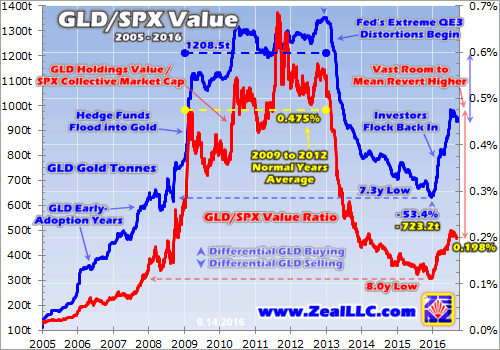
In late August, American stock investors had only 0.198% of their portfolios allocated to gold per this GLD/SPX ratio! That’s really low relative to their own precedent after GLD’s early-adoption years, which averaged 2.4x higher in that post-panic pre-QE3 normal-year span between 2009 to 2012. So they have vast GLD buying still left to do even from here merely to mean revert and normalize their gold exposure.
This young gold bull’s overwhelmingly-dominant driver, heavy differential GLD-share demand from large American stock investors, is far from over. Once normal stock-market cycles driven by valuations again overpower central banks’ false assertion that they’ve been eradicated, gold investment demand will come roaring back. And that will ignite and fuel gold’s next major upleg, likely again led by GLD inflows.
While GLD isn’t the whole story of gold’s young new bull, it’s certainly the vast majority. The remainder has been driven by gold-futures trading by American speculators. As I warned back in mid-July, these guys added new long-side bets so aggressively last summer that they soared to all-time records. That made for a record gold-futures selling overhang that has really dogged gold in recent months, truncating any rallies.
With speculators’ hyper-leveraged gold-futures longs remaining at near-record levels ever since then, this elite group of traders hasn’t had sufficient dry powder to bid gold higher. This too has contributed to the stalling gold prices in recent months. But digging into what’s going on in gold futures in depth would require another whole essay. While important, the gold-futures developments take a back seat to GLD buying.
Gold stalled out in this third quarter because large American stock investors halted their diversification into gold via GLD shares. The miraculous resurgence of the long-in-the-tooth stock bull to a streak of new records this summer despite the Brexit vote’s success rekindled recent years’ love affair with stocks. But when these lofty overvalued stock markets unavoidably roll over, gold investment demand will soar again.
Investors can certainly play gold’s coming next upleg with GLD shares or physical gold coins. Gold is essential for all portfolios, as its tendency to move counter to stock markets provides a critical hedge for the rest of portfolios. But once that foundation is in place, gold’s gains will be dwarfed by those of the elite gold miners’ stocks. Their profits greatly leverage rising gold prices, yielding stock-price gains many times gold’s own.
That’s long been our specialty at Zeal. We’ve spent tens of thousands of hours researching gold stocks and markets, so we can better decide what to trade and when. This has resulted in 844 stock trades recommended in real-time for our newsletter subscribers since 2001. Their average annualized realized gains including all losers are running way up at a stellar +23.4%! We can help you multiply your wealth too.
We’ve long published acclaimed weekly and monthly newsletters that discuss our trades and market timing. They draw on our vast experience, knowledge, wisdom, and ongoing research to explain what’s going on in the markets, why, and how to trade them with specific stocks. Now is a fantastic time to get onboard, as we have a major new gold-stock and silver-stock deployment well underway to ride gold’s next upleg. Subscribe today! For just $10 an issue, you can learn to think, trade, and thrive like a contrarian.
The bottom line is gold’s young new bull market has stalled because American stock investors ceased aggressively buying GLD shares in the third quarter. The stunning new stock-market record highs soon after the long-feared Brexit vote this summer shifted attention away from gold back to stocks. Investment demand for gold wanes when stocks apparently do nothing but rally indefinitely, as recent years proved in spades.
But as these lofty, overvalued, central-bank-goosed stock markets inevitably roll over, American stock investors will once again look to counter-trending gold for prudent portfolio diversification. It was their heavy differential buying of GLD shares that catapulted gold sharply higher in the first half of 2016, so their return to gold buying will also ignite and fuel gold’s next major upleg. Get deployed now, before it arrives.

The failure of Gold and gold stocks to sustain recent gains coupled with a strong selloff to close the week dashes any hope that the correction ended last week. The charts and probabilities argue that the sector remains in a larger correction and perhaps has started the C portion of a typical A-B-C (down-up-down) correction.
This week started out strong for the miners but that strength faded and was completely reversed with Friday’s selloff. GDX and GDXJ closed down 3%-4% for the week and left nasty bearish candles on the weekly charts. GDXJ, which made a low of $41 last week could test at least $39 while GDX, which tested a low of $25 last week has downside potential to $22.
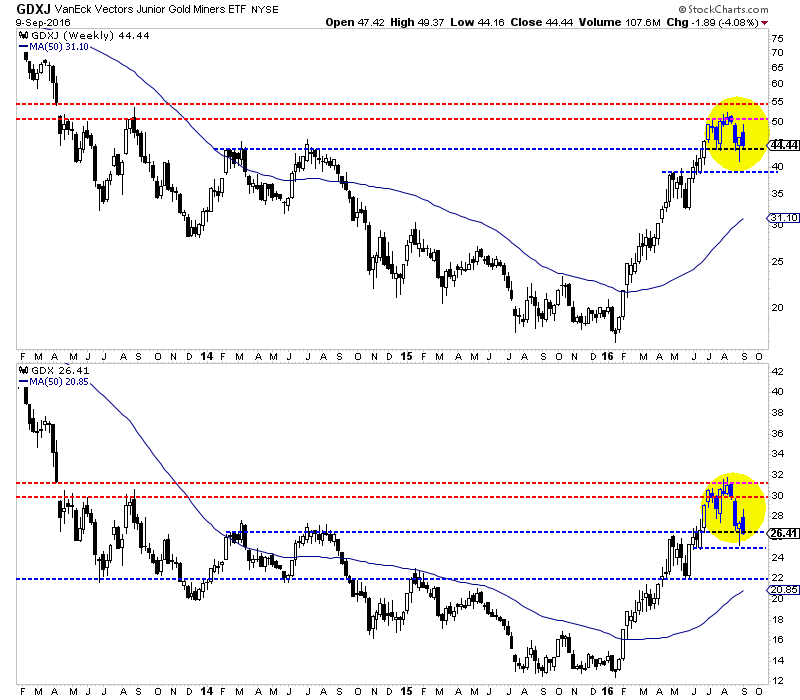
Before I get to Gold, here is an important note on GDX. During bull market corrections, GDM, the parent index of GDX often found support at its 400-day exponential moving average. This happened seven times during 2002-2003, 2006 and 2009-2010. The 400-day exponential moving average for GDX is currently at $22 and rising slowly. Hence, I consider $22-$23 as a potential bottom for GDX.
Turning to Gold, we note that Gold failed at the $1355-$1360 resistance earlier in the week. That coupled with Friday’s decline increases the odds that Gold will head lower to the bottom of its channel near $1300. Gold closed at $1334. It has support at $1300-$1310 and $1275-$1280.
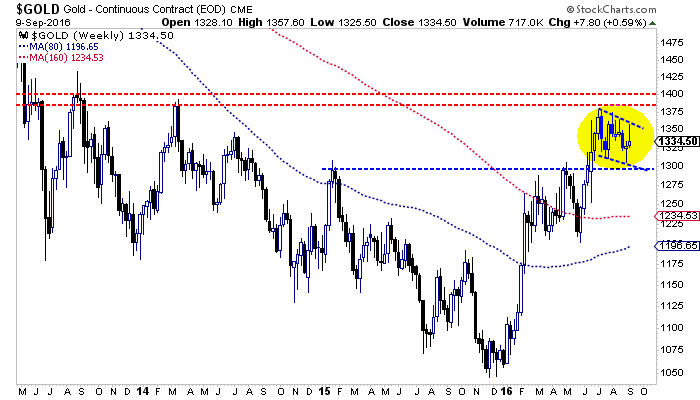
The negative reversal in miners and metals at the end of this week (and their failure to hold the rebound) signals that a larger and longer correction is playing out and more downside potential is directly ahead. GDX closed at $26.41. It has a very strong confluence of support around $22 which includes its 200-day moving average, its 400-day exponential moving average (noted above) and the 50% retracement of the entire rebound. Do not be surprised if this target is reached quickly, such as in days and not weeks. Remember that fishing line type declines (think of the trajectory of a fishing line) are a buying opportunity.

1. Gold has a rough general tendency to decline ahead of the monthly US jobs report, gyrate wildly when the report is released, and then rally modestly higher for another one to three weeks. The cycle tends to repeat itself with varying degrees of intensity.
2. Please click here now. Double click to enlarge this daily bars gold chart.
3. It’s clear that gold responded to the latest jobs report in “textbook” fashion. I suggested gold would decline to about $1310 ahead of the jobs report. It went to about $1306.
4. Since then, gold has rallied to about $1335 and the technical situation is now very good. Note the 14,7,7 series Stochastics oscillator at the bottom of the chart. There’s a crossover buy signal in play.
5. Even though Indian demand is currently soft, gold is very well supported by institutional money managers. At this point in time, it could be persuasively argued that neither the love trade nor the fear trade are the prime movers of the gold price.
6. Instead, gold is being supported by the “competitive cost of carry” trade. Low rates and negative rates on most fiat currencies make gold very attractive as a currency.
7. Please click here now. Double click to enlarge. Silver also looks well supported, and the chart “feels” solid.
8. The cost of carry theme means that in the short to medium term, a big price spike higher is unlikely, and a big tumble lower is equally unlikely. Obviously, at some point the fear trade will come back into play, and it’s very late in the game for the US business cycle.
9. The US stock market tends to lead the economy by about six months. A rollover to the downside could happen any time between now and 2018, with September, October, and January being the most likely months for a meltdown to commence.
10. Please click here now. Double click to enlarge this daily bars dollar versus yen chart.
11. Since tumbling to the 100 area on the Brexit event, the dollar has steadied and traded sideways between 100 and 107. The FOREX market is the largest market in the world, and price action of the dollar versus the yen has a huge effect on the gold price.
12. Just as the dollar has rolled sideways against the yen since the Brexit, gold has drifted sideways in a rough $1370 to $1310 price range.
13. In Japan, central bank chief Kuroda is likely to cut interest rates again at the upcoming September 21 He’s also likely to increase his QE program.
14. Kuroda may also try to stimulate bank lending by targeting his bond purchases at different types of bonds. If he’s successful, bank lending is inflationary, and good for gold.
15. If he fails, gold will still benefit from the overall drop in interest rates. That’s because the drop in rates makes gold more competitive with fiat from a cost of carry perspective.
16. The US central bank is also holding a key policy meeting on September 21. A rate hike should create a spike in fear trade demand for gold, because it would likely hit the stock market very hard.
17. Amateur gold price enthusiasts should take note of the fact that gold is owned as a competitive currency by a myriad of unleveraged institutional money managers.
18. In 2008, gold’s main owners were leveraged funds. Gold is in much stronger hands now than it was in 2008, and in the case of a stock market crash, gold may act quite a bit differently than it did in 2008.
19. There’s a growing loss of confidence theme amongst institutional money managers, in regards to central banks around the world. Increasingly, gold is replacing T-bonds, and becoming the most favoured safe haven.
20. Please click here now. Double click to enlarge this daily bars oil chart.
21. Yesterday was a very important day for the global oil market; Russia and Saudi Arabia announced a “cooperation pact”. Oil spiked about two dollars higher on the news, and it may put a new floor under the oil price. The door to production cuts from OPEC is now open.
22. US jobs reports show that jobs growth is probably peaking out. A price floor and even modestly higher oil prices will cause more money managers to begin to utter the stagflation catch phrase. That’s good news for gold.
23. Please click here now. Double click to enlarge this key daily bars GDX chart. Both the $21 and $25 price zones are superb entry points for gold stock enthusiasts, and traders can be light sellers in the $27.50 and $32 area.
24. Gold stocks are very well supported now, because gold is well supported by the competitive cost of carry trade. Against gold, gold stocks have been in a bear cycle since 1996. That cycle appears to be ending now, and its end will be confirmed by an upturn in bank loan profits and money velocity. A rising oil price floor could be the catalyst that creates the upturn. For the Western gold community, good times are here, and great times are near!
Stewart Thomson of Graceland Updates, Guest Contributor to MiningFeeds.com
If you would like to receive our free newsletter via email, simply enter your email address below & click subscribe.
CONNECT WITH US
Tweets
Tweet with hash tag #miningfeeds or @miningfeeds and your tweets will be displayed across this site.
MOST ACTIVE MINING STOCKS
Daily Gainers
 Lincoln Minerals Limited Lincoln Minerals Limited |
LML.AX | +125.00% |
      |
GCR.AX | +33.33% |
      |
CASA.V | +30.00% |
      |
AHN.AX | +22.22% |
      |
ADD.AX | +22.22% |
      |
AZM.V | +21.98% |
      |
NSE.V | +21.05% |
      |
DYG.V | +18.42% |
      |
AAZ.V | +18.18% |
      |
GLA.AX | +17.65% |

 Follow us on Twitter
Follow us on Twitter Become our facebook fan
Become our facebook fan








